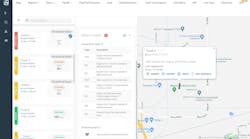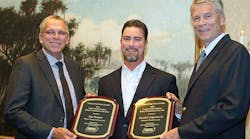FIRST, the bad news: 28% of truck drivers have Obstructive Sleep Apnea (OSA), and those who are untreated are three to seven times more likely to crash.
Beyond that, OSA leads to other major and costly chronic diseases. It triples the risk of a heart attack and stroke and doubles the risk of being forced out of a truck driving job into early retirement.
“That’s a horrible waste of talent,” said Adrian Knight, senior vice-president of Clinical Operations at Sleepsafe Drivers Inc. He was one of two speakers discussing sleep apnea during the National Tank Truck Carriers Tank Truck Safety & Security Council Annual Meeting New Orleans, Louisiana.
Now, the good news: Treatment improves truck driving safety and overall health.
Waste Management’s sleep apnea program showed a 79% reduction in short-term disability costs and a 72% reduction in short-term disability days absent.
“We’ve all got driver groups that are in their 50s, heading for their 60s, and they’re going to be retiring,” Knight said. “Millennials aren’t going to come in to fill their place. We’re all having trouble filling those trucks, and if you’ve got guys with untreated sleep apnea, they’re going to be forced out of their jobs much sooner. That’s a terrible waste of talent.”
In a five-year program at JB Hunt, there was a 53% reduction in accidents, 55% reduction in hard braking, 56% reduction in medical costs, and a reduction in sleepiness and fatigue.
Knight said sleep apnea is an episode of not breathing. The causes: blocked or narrowed airways in your nose, mouth, or throat; large tonsils, adenoids, uvula, or neck size; being overweight or taking certain medications; drinking alcohol before bed and sleeping on your back. It’s primarily for those over 50 years old. It’s believed that OSA afflicts at least 15 million in the US—and over 90% remain undiagnosed.
OSA occurs when the upper airway collapses during sleep for between 10 seconds and several minutes, up to 400 times a night, causing cessation of breathing (apnea) or inadequate breathing (hypopnea) and sleep fragmentation.
There are two types of sleep apnea:
• OSA. This is 94% of apneas. The throat muscles relax and collapse, causing an obstructed airway.
• Central sleep apnea. This is 6% of apneas. The brain doesn’t send proper signals to control breathing.
Most common symptoms: excessive daytime sleepiness/fatigue; spouse complaint of snoring; hypertension (high blood pressure); diabetes; heart attack/stroke; acid reflux (GERD, gastro esophageal reflux disease); morning headaches; moodiness; Erectile Dysfunction/impotence.
Knight said you can live three weeks without food and five days without water, but you can only live seven minutes without oxygen—and apnea cuts the oxygen level delivered to the brain.
The potential health consequences if sleep apnea remains untreated:
• Short-term. Excessive sleepiness/fatigue, decreased quality of life, performance deficits, and reduced alertness (BAC = .06).
• Long-term. Two times the rate of hypertension, heart disease, heart attack, and stroke. Impaired glucose tolerance. Two times the chance of forced retirement due to health.
Knight said the consequences of untreated sleep apnea are devastating. He presented nine examples, the most recent of which occurred in Georgia in May. An investigation showed that a truck driver, who had been fired from a previous job in 2011 for falling asleep at the wheel of a truck and causing an accident, hit the cars ahead of him at full highway speed, never hitting his brakes or attempting evasive action. Five people were killed, resulting in a lawsuit.
The treatment for apnea involves a sleep study, which is a painless study done in an ambulatory or lab setting to monitor patient’s sleep and breathing patterns. The study may record the following: brain-wave activity; respiratory pattern and snoring; heart rate; and chest and leg movement. The identification and treatment of the sleep disorder is the goal.
Therapy for patients with apnea:
• CPAP (“continuous positive pressure”). One level of pressure is delivered upon inhalation and exhalation. It may require re-testing in subsequent years (pressure needs change). It’s the industry standard and is the least expensive.
• APAP (auto titration therapy). It’s best for long-term compliance. Pressure is continually adjusted to keep a patient’s airway open. It delivers lower and more comfortable pressures. No retests are needed.
• Bi-level therapy. This is for the 6% of patients with high-pressure needs. There is one level of pressure on inhalation, and lower on expiration.
Knight said a treatment program delivered $4.7 million in net medical cost savings at Union Pacific Railroad. An education plan for participants about sleep apnea resulted in a 145% higher participation in PAP therapy. PAP participants had a lower hospital admission rate and lower in-patient costs than non-PAP participants.
Program safety guidelines:
• Increase the safety and health of commercial drivers.
• Meet pending FMCSA guidelines for sleep disorders.
• Meet federal and state guidelines for the provision and billing of medical and clinical services.
• Meet AASM guidelines for provision of sleep medicine services.
• Meet federal guidelines for privacy rights (HIPAA).
The goals are to get the drivers screened, tested, and treated in one to three days; create a sleep apnea program with proven protocols that are executed with consistency and based on defined criteria in the areas of screening, diagnosis, treatment, and usage compliance; make it seamless for drivers and managers; and help avoid claims of discrimination borne of inconsistency.
“Proactive sleep programs create net savings and ROI,” he said. “Every single fleet that we’re aware of has saved money and reduced accidents. There hasn’t been a single study that said it had no effect or it went the other way. Some people have said, ‘We don’t think this is significant.’ But there are dozens of studies. Untreated apnea results in greater liability, with lawsuits ranging from $10 million to $62 million. Those were all unnecessary. We can cut the risk by a factor of about three.
“Sleep programs designed for transportation are successful. If it’s designed for trucks, it’s successful. If you are just kind of letting drivers get screened and then going to random hospitals and getting sleep-tested and treated, that’s better than nothing. But there’s a 50% chance it will fail because it’s not designed for truckers.” ♦
View more 2015 NTTC Safety Conference coverage >
Find the NTTC Safety Conference archive with articles from 2012 to present









![Alan Roberts [center left], Wynne Transport Service, and David Edgerton [center right], Tidewater Transit Inc, are congratulated on being named Tank Truck Safety Professionals of the Year by Dan Furth [far left], NTTC president, and Paul Baumgardner [far right], FMCSA. Alan Roberts [center left], Wynne Transport Service, and David Edgerton [center right], Tidewater Transit Inc, are congratulated on being named Tank Truck Safety Professionals of the Year by Dan Furth [far left], NTTC president, and Paul Baumgardner [far right], FMCSA.](https://img.bulktransporter.com/files/base/ebm/bulktransporter/image/2019/04/bulktransporter_1013_nttc_2011_safety_wynne_tidewater.png?auto=format,compress&fit=crop&q=45&h=139&height=139&w=250&width=250)
